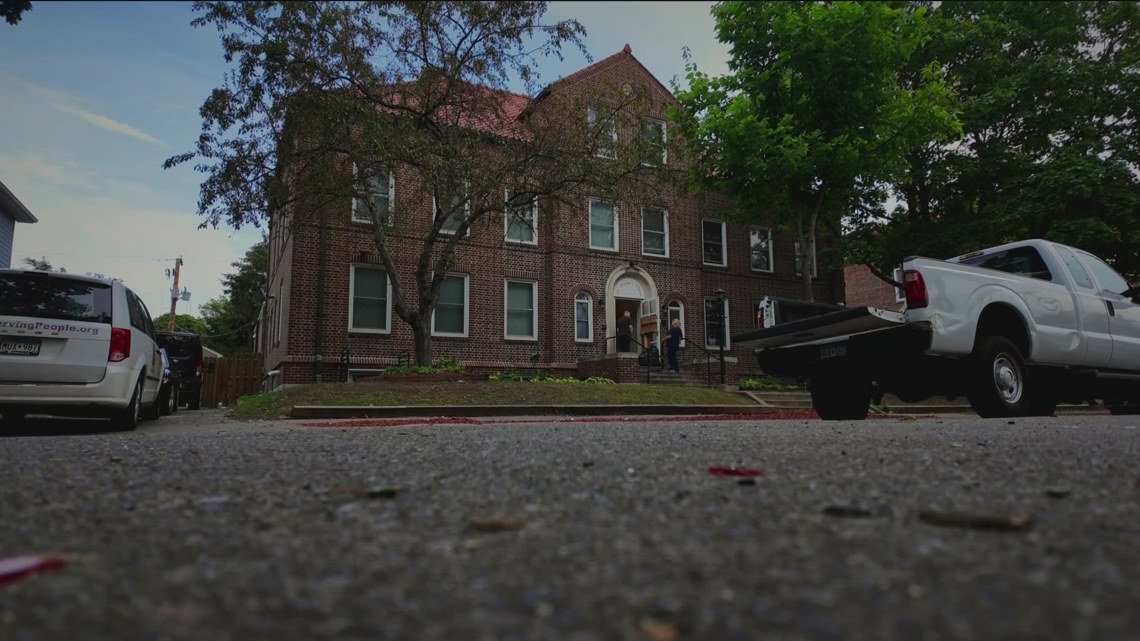Star Tribune
Minnesota housing finance agency is making racial segregation worse, Black organization claims

A Black civil rights organization claims that a state affordable housing finance agency is worsening racial segregation — and that the group’s concerns about it are not addressed in an upcoming report to the U.S. Civil Rights Commission.
The Rev. Alfred Babington-Johnson, CEO of Minneapolis-based Stairstep Foundation, which works with more than 100 Black churches, delivered testimony to the commission’s Minnesota Advisory Committee saying that the housing agency has not encouraged or allocated subsidized housing appropriately.
The testimony came a year after he sued Minnesota Housing, the state agency, alleging it was preventing adequate construction of subsidized housing in affluent, predominantly white areas. As a result, the suit says, many low-income, nonwhite residents are barred from accessing economic and educational opportunities in those places. The suit also named the Metropolitan Council as a defendant.
“Contrary to their mandate, these entities have not encouraged or allocated subsidized housing development appropriately, and as a consequence, they have become complicit in advancing racial segregation and causing economic disadvantage to vulnerable segments of our society, particularly the Black community,” Babington-Johnson testified.
But mention of the Ramsey County suit and the issues it raised were struck from a draft of an upcoming report to the Civil Rights Commission.
Advisory committee chair Beth Commers told the Star Tribune that the panel started trying to conduct an analysis of Minnesota Housing’s strategic plan. But after listening to testimony from many people on housing issues that went beyond that agency, the panel broadened the report’s scope to address civil rights themes in housing affordability and equitable access to housing in Minnesota. Commers noted that one issue they heard, for example, was insufficient money for the repair and upkeep of affordable units.
The panel removed mention of Babington-Johnson’s lawsuit in a draft because “it didn’t fit, and … we didn’t want to take a position on a case that’s in front of the court,” Commers said. Some of Babington-Johnson’s remarks remain.
Commers said the committee’s final report of recommendations on affordable housing in Minnesota will be published in about two weeks. One top recommendation is state legislation setting zoning requirements for municipalities across Minnesota to allow for more diverse affordable housing stock – for example, six- to eight-unit buildings, instead of mostly single-family homes.
“Otherwise, communities get to choose … what kind of housing to allow and what kind of housing to not allow,” Commers said.
Committee Member William Stancil was the sole panelist opposing the changes, questioning why they had repeatedly invited Babington-Johnson to testify and then removed mention of the suit. He voiced concern that the report was siding with industry groups that oppose the ideas Babington-Johnson put forth.
One such group called Equity in Place, for example, told the committee that it sees the “areas of opportunity” framework — the crux of Babington-Johnson’s lawsuit and testimony — as a dated one that might appear to serve the interests of people of color, the working class and low-wealth renters but is leading to a pattern of reducing affordable housing investment in communities that are mostly people of color. Equity in Place, a coalition of organizations led by people of color and housing advocacy groups, argued that this policy is often used against communities of color trying to fight against pressures of gentrification and displacement.
Minnesota Housing funds more subsidized units in the Twin Cities than any other entity and allocates Low-Income Housing Tax Credits.
In its lawsuit, Stairstep Foundation said 35% of the region’s subsidized affordable housing is located in “racially concentrated areas of poverty,” and only 1.3% of such housing is located in “racially concentrated areas of affluence.” In census tracts greater than 30% nonwhite in Minneapolis and St. Paul, there is approximately one subsidized housing unit for every four nonsubsidized units, according to the suit. But in tracts less than 30% nonwhite, there is about one subsidized housing unit for every 24 nonsubsidized ones.
Minnesota Housing and the Met Council denied the lawsuit allegations in court papers filed last month, though the former admitted that the region’s housing is racially segregated by some metrics.
During testimony, Minnesota Housing Commissioner Jennifer Leimaile Ho objected to a statement in the report that most affordable housing in the state has been built in the urban core of Minneapolis and St. Paul. The report, she said, needs to make clear that Minnesota Housing is not “concentrating” or “clustering” affordable housing.
In the last several years, she said, 63% of the new rental units in the Twin Cities metro area that have been awarded funds through the agency’s Consolidate Request for Proposals have been in the suburbs while 37% have been in Minneapolis-St. Paul. Ho added the agency is actually funding housing in a wide range of communities.
Babington-Johnson and University of Minnesota Law School Professor Myron Orfield dispute those numbers. Orfield, who also testified before the committee, said the share of Minnesota Housing funding going to the suburbs is 41% over the last five years, though the suburbs are 75% of the metro area. Minneapolis and St. Paul have 60% of the units even though they have 25% of the population, he said.
Babington-Johnson wrote a letter to the committee in June raising objections that the advisory committee had “abruptly stripped” reference to the civil rights issues on which he had testified, but that it incorporated Ho’s statistics. He said the committee had fallen short of its obligation to fully incorporate all civil rights concerns.
John Powell, professor of African American Studies and Ethnic Studies at University of California at Berkeley, also wrote to the committee saying he strongly objected to striking references to the “opportunity neighborhood framework” that is embedded in America’s fair housing law — a central part of Babington-Johnson’s lawsuit. He said the suit against Minnesota Housing is one of the most important fair housing cases before the courts nationwide.
Star Tribune
Man charged in shooting, armed standoff with police at south Minneapolis apartment building
A 40-year-old man was charged Thursday with three felony assault counts for allegedly shooting up his south Minneapolis apartment building last weekend, prompting a standoff with police before an officer shot and disarmed him.
According to the criminal complaint, Nathan Mellstrom Matz fired numerous shots with an AK-47 rifle sometime before 4:30 a.m. Saturday at the apartment building, in the 4000 block of Minnehaha Avenue in the Longfellow community. Several 911 calls summoned the police, who evacuated residents before finding Matz in a stairwell holding the rifle.
An officer gave Matz a minute and 20 seconds to drop the gun before firing a single shot at him. The suspect was taken by ambulance to the hospital, where he was expected to survive his wound. No one else was injured in the episode.
One resident told police he heard gunfire, stepped out in the hall and ran back into his apartment when he saw the gunman down the hall, who fired and nearly hit him. Another resident said he heard gunshots through his floor and found bullet holes there. A homeowner across the street said her house was hit by bullets and that she believed it was targeted during the shooting.
Matz is charged with three counts of second-degree assault with a dangerous weapon, but prosecutors may seek an aggravated sentence because, among other things, the shooting occurred in a densely populated area.
Star Tribune
Minnesota regulators narrowly approve gas pipeline near Pipestone monument

During the hearing, the Mille Lacs Band backed away from its original route and aligned with the Upper Sioux Community, which proposed an even longer route but also stated that it preferred the pipeline never be reopened.
The Yankton Sioux Tribe and the Flandreau Santee Sioux Tribe also opposed the project.
And on Thursday, Nina Berglund, a member of the Northern Cheyenne and Oglala Lakota tribes brought a sample of pipestone for the commission to see as they deliberated in a downtown St. Paul hearing room. She shed tears as the monument superintendent described the significance of the area.
“To have it be able to represent itself in a room where everyone’s talking about it and no one knows what it looks like,” Berglund said of the pipestone.
Nina Berglund, a member of the Northern Cheyenne and Oglala Lakota tribes and a Minneapolis resident, holds a piece of pipestone from Pipestone National Monument and a bunch of sage on her lap during a Minnesota Public Utilities Commission meeting at the Metro Square building in St. Paul, Minn. on Thursday, Sep. 12, 2024. The commission discussed options surrounding a permit for Magellan Pipeline Company to build a pipeline near Pipestone National Monument. ] ALEX KORMANN • alex.kormann@startribune.com (Alex Kormann/The Minnesota Star Tribune)
Brusven said granting a route permit would make it easier for Magellan to survey the route because they would be less reliant on landowners granting them access to look for items of cultural significance.
Tuma said if Magellan runs into anything, including catlinite, they would have to route the pipeline to avoid it. He drove the site personally as he researched the issue and was confident the ruling will bring a “thorough examination” of the route before construction.
Star Tribune
Deputies justified in killing Minnetonka man during gunfight

The Hennepin County Attorney’s Office said Thursday that sheriff’s deputies were legally justified when they killed a man in Minnetonka during a shootout at his home.
Clint Lavelle Hoyhtya, 28, was shot multiple times during the firefight late in the morning of April 10 at a home in the 13400 block of E. Crestwood Drive. Two deputies at the scene were shot and survived their wounds.
Deputies were serving an arrest warrant when gunfire erupted. Hoyhtya died at the scene. Dispatch audio and a law enforcement source also confirmed that Hoyhtya was not the subject of Wednesday’s warrant.
County Attorney Mary Moriarty said that her office reviewed the state Bureau of Criminal Apprehension’s (BCA) investigation and office found no evidence of unlawful conduct by law enforcement during its encounter with Hoyhtya.
Two of the four deputies who shot at Hoyhtya were wounded during the firefight. Christopher Heihn was hit multiple times, was taken to HCMC for treatment and has since been released. Keith McNamara was treated at the scene after being hit by shrapnel.
Moriarty said her office determined that the deputies acted lawfully, initially retreating to find cover, calling for a negotiator and attempting to persuade Mr. Hoyhtya to stop shooting. She said the deputies exercised restraint and did not resort to deadly force until it became necessary, namely when Mr. Hoyhtya shot at them.
“In our review of the BCA’s investigation, we found no unlawful conduct by law enforcement,” a statement from Moriarty ready. “This was a terrifying incident that left [a sheriff’s] deputy hospitalized with a gunshot wound, endangered the lives of several other deputies and community members, and led to the death of Mr. Hoyhtya.”



